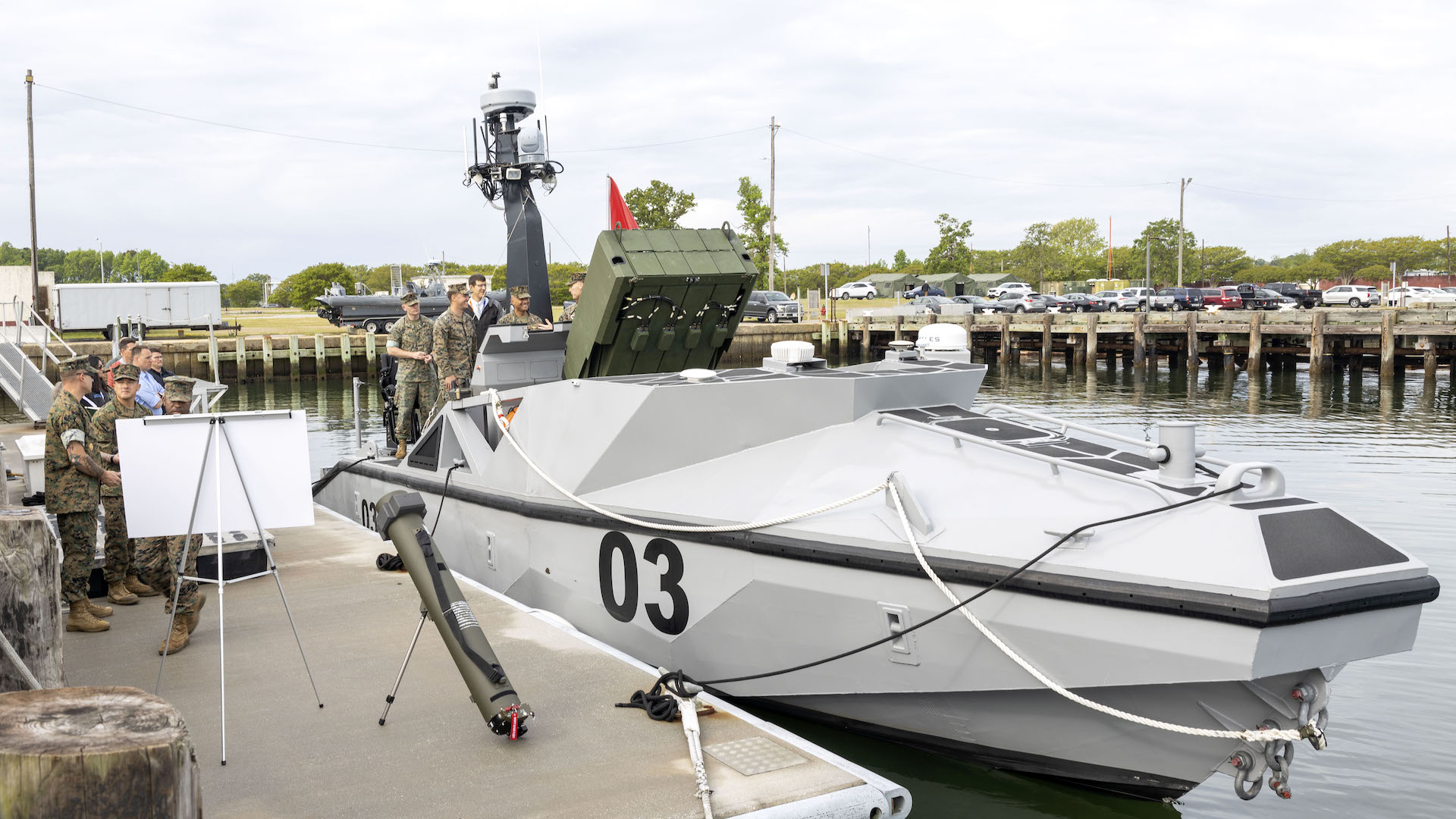

In the latest evidence that we are living in the golden age of missile-hauling robots, the Marine Corps has released photos showing its future unmanned drone boat loaded up with a launcher for loitering munitions to take out targets in a potential near-peer conflict.
Photos published to the Defense Visual Information Distribution Service on Tuesday and first reported by The War Zone showed the Marine Corps’ Long Range Unmanned Surface Vessel (LRUSV) developed by Louisiana-based shipbuilder Metal Shark outfitted with a launcher for the Uvision Hero-120 the service selected as it’s so-called Organic Precision Fire-Mounted (OPF-M) solution.
The photos show Lt. Gen. Brian W. Cavanaugh, the commanding general of Fleet Marine Force, Atlantic, Marine Forces Command, Marine Forces Northern Command, and Marines from the newly-formed 3rd Marine Littoral Regiment (MLR) inspecting a fully loaded LRUSV at Joint Expeditionary Base Little Creek-Fort Story in Virginia this past April.
The LRUSV “is a semiautonomous vessel capable of extended travel and transporting loitering munitions that accurately track and destroy targets on sea or land,” according to the Marine Corp’s description on DVIDS. “It will primarily serve as an intelligence, surveillance, and reconnaissance platform.”
Subscribe to Task & Purpose Today. Get the latest military news, entertainment, and gear in your inbox daily.
Loitering munitions, frequently referred to as ‘kamikaze drones,’ are best described as airborne bombs that circle above a set area, scan for targets, and then attack from above.
The Hero-120 in particular — selected in June 2021 for the Corps’ OPF-M competition to enhance the fire support capability of the LRUSV, the Light Armored Vehicle-Mortar (LAV-M), and the Joint Light Tactical Vehicle (JLTV) — can loiter for up to an hour over ranges of up to 60 km before delivering its 4.5 kg warhead, according to the manufacturer.
As The War Zone notes, the Hero-120 can also conduct surveillance and reconnaissance functions without attacking a target and be recovered for future use, making them an essential piece of the ISR capabilities the Corps details for the LRUSV.
“LRUSVs, employed individually or in formations of multiple vessels under the cognizance of a LRUSV company or subordinate element will be unmanned vessels, capable of conducting semi-autonomous maneuvers in the open ocean for extended periods of time,” according to the Navy’s fiscal year 2024 budget request, which proposes $25.25 million for funding the development of the platform that year.

As the budget documents note, the development and employment of LRUSVs is a “priority” within the Marine Corps Force Design 2030, the service’s broad reorganization that will see it become lighter and more nimble ahead of a protracted fight in the Indo-Pacific region against a future adversary like China that has seen the service divest itself of its M1 Abrams tanks and reduce the size and scope of its ranks.
Force Design 2030 has also seen the Corps stand up new units like the aforementioned 3rd MLR, previously described by the Corps as a self-deployable, multi-domain force that is “relatively easy to maintain and sustain as part of a naval expeditionary force” in a future island-hopping campaign in the Pacific.
Indeed, the Corps notes MLRs will prove integral elements in future Expeditionary Advanced Base Operations. EABO is a concept that calls for deploying a relatively small number of Marines on “a series of austere, temporary locations ashore or inshore within a contested or potentially contested maritime area in order to conduct sea denial, support sea control, or enable fleet sustainment,” according to the Corps.
While the Corps’ Force Design 2030 update in May 2022 states that MLR experimentation will help determine “the correct echelon of command” within a future Marine Expeditionary Force for the employment of the armed LRUSV, organizational specifics aren’t preventing the service’s parent branch from also developing munition-hauling robot boats for future EABO missions.
As Task & Purpose previously reported, the Navy is eyeing the so-called “Multi-domain Area Denial from Small-USV (MADS)” consisting of Greenough Advanced Rescue Craft (GARC) drone boats outfitted with FIM-92 Stinger missile launchers to potentially “provide a low-cost, persistent anti-air and anti-surface maritime defense capability” for transportation vessels associated with EABO and littoral operations, as well as those tied to Military Sealift Command.
“During future conflicts, U.S. and allied forces will be greatly outnumbered by peer or near-peer competitors in both tactical platforms and munitions,” according to the Navy’s fiscal year 2024 budget documents. “Large numbers of small, low signature, attributable unmanned missile launching vessels have the potential to improve surface force magazine depth and reduce risk to force in denied areas.”
It’s unclear what a future fleet of LRUSVs might look like. According to a 2021 Breaking Defense report, the long-term goal of the Corps is to procure up to 100 armed LRUSVs explicitly for surveillance and strike missions by 2030.
The latest on Task & Purpose
- 7 Hollywood actors who made the most realistic GWOT operators on screen
- How a Marine’s COVID-19 vaccine refusal led to 113 days in the brig
- Russia lost a hypersonic missile trying to destroy one of Ukraine’s Patriot missiles
- Air Force F-15 takes an accidental bath in drainage canal after botched landing
- Fort Cavazos battalion commander fired for misconduct